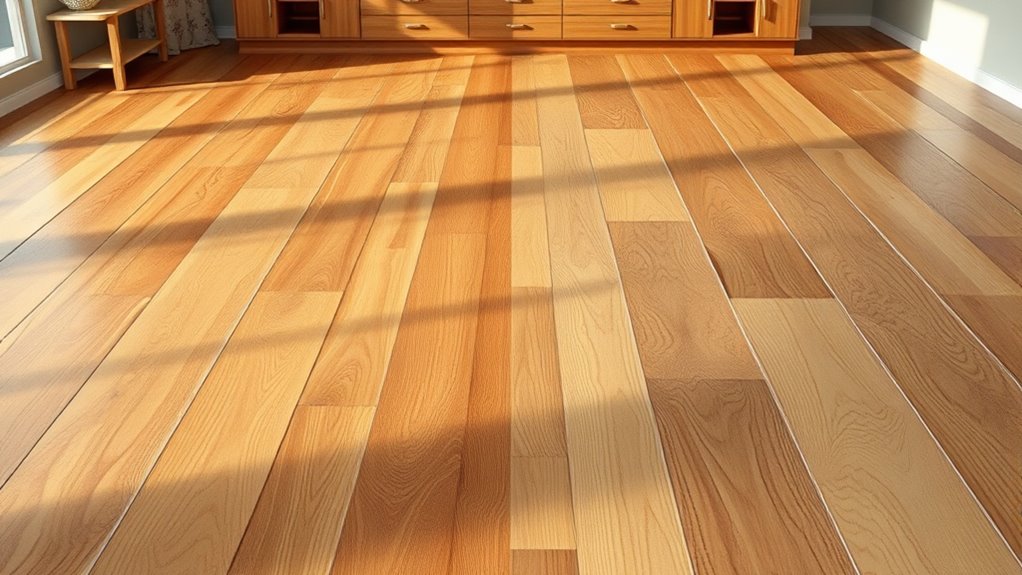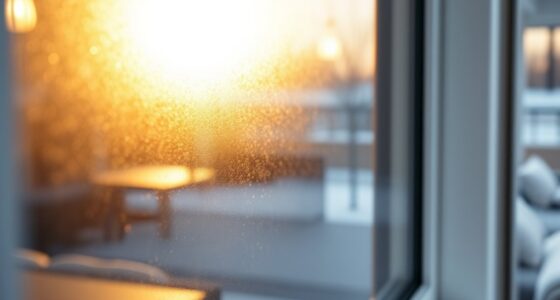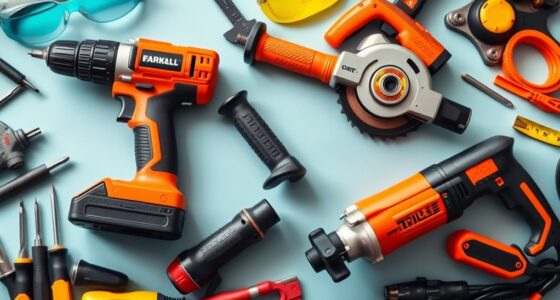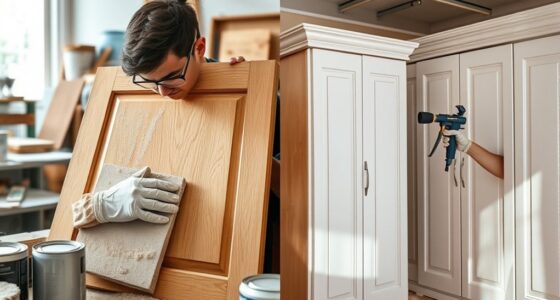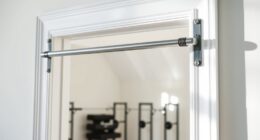When comparing durability, laminate flooring tends to win in scratch and dent resistance thanks to its tough wear layer, making it ideal for high-traffic areas and households with pets. Hardwood can last over 50 years if well-maintained, and you can refinish it multiple times to renew its look. However, hardwood is more prone to scratches, dents, and moisture issues. To discover which option best fits your needs and how to maximize their lifespan, keep exploring more details.
Key Takeaways
- Hardwood floors last over 50 years and can be refinished multiple times, extending their lifespan.
- Laminate offers superior scratch and dent resistance due to its tough wear layer, making it highly durable in high-traffic areas.
- Laminate has limited water resistance and can swell or delaminate with high moisture exposure, unlike hardwood which is sensitive to humidity.
- Hardwood can be sanded and refinished to remove damage, while laminate cannot be repaired and needs replacement if damaged.
- Both materials vary in longevity, with hardwood generally lasting longer and adding more home value than laminate.
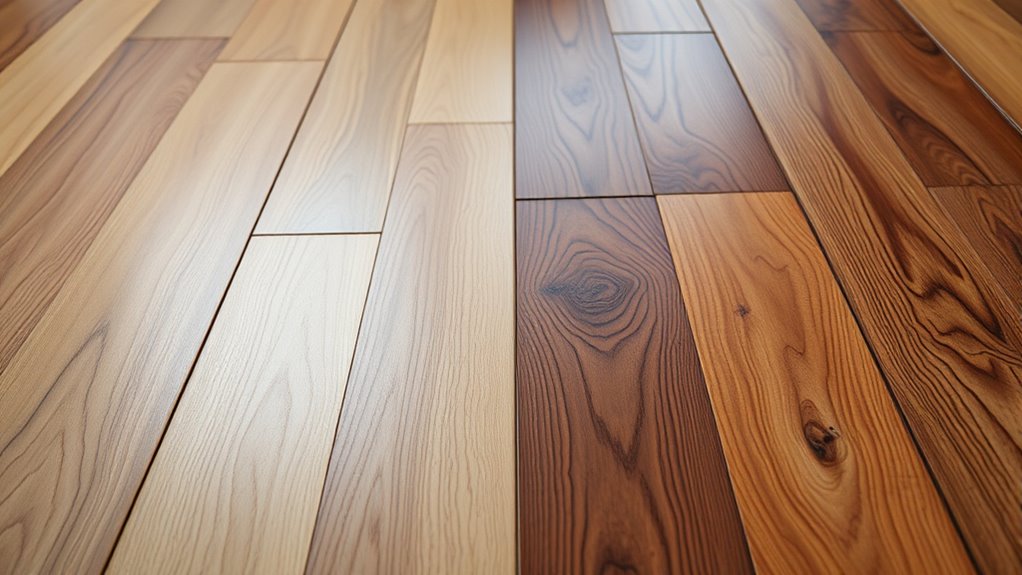
When choosing between laminate and hardwood flooring, understanding their key differences helps you make an informed decision. Durability is a major factor, and each material offers distinct advantages and limitations. Hardwood floors are known for their impressive longevity, often lasting 50 years or more with proper care. You can sand and refinish hardwood multiple times to remove scratches and dents, which effectively extends their lifespan and keeps them looking fresh. This ability to be rejuvenated makes hardwood a durable choice for long-term investment, especially if you’re willing to maintain it regularly.
Hardwood flooring lasts 50+ years and can be refinished multiple times for lasting beauty and durability.
In contrast, laminate flooring typically lasts between 15 to 25 years, depending on quality and upkeep. Once the surface becomes worn or damaged, laminate cannot be refinished; you’ll need to replace it entirely. However, advances in laminate technology, such as tough external layers and resin coatings, have enhanced durability, and some high-quality laminates now boast longer lifespans. Despite this progress, laminate generally can’t match hardwood’s ability to be restored through refinishing, which makes it less suitable for high-traffic areas over decades.
When it comes to resisting scratches and dents, laminate flooring has the upper hand. Its robust wear layer offers excellent protection against everyday damage like scratches, dents, and stains. This makes laminate a popular choice for households with pets or heavy foot traffic, where durability is a priority. Hardwood, while aesthetically superior, is more prone to showing scratches and dents, especially in high-traffic zones. The extent of vulnerability depends on the wood species; for example, oak and hickory are more durable than softer woods. Still, hardwood can show signs of wear more quickly if not maintained properly, requiring more attentive care over time.
Water and moisture resistance also vary considerably. Laminate flooring tends to have limited water resistance, with high moisture levels causing swelling or delamination, although newer products have improved this aspect. Hardwood is sensitive to humidity shifts, which can lead to warping, expansion, or gaps between planks. Proper acclimatization and controlled indoor humidity are essential for hardwood to maintain its integrity. Neither material is fully waterproof, so exposure to standing water should be avoided. Applying protective coatings can help, but hardwood generally needs more careful management to prevent moisture damage. Selecting the right flooring material based on your environment and lifestyle can significantly impact its durability and appearance over time.
In terms of maintenance, hardwood requires regular cleaning and periodic refinishing to preserve its look and durability. Laminate, on the other hand, needs minimal upkeep—just sweeping and damp mopping usually suffice. When damaged, hardwood can be refinished to restore its appearance, but this process can be costly. Laminate doesn’t offer that option; once the surface wears or chips, it’s time for replacement. Overall, laminate’s wear layer simplifies maintenance, making it a practical choice for busy households or rental properties, while hardwood’s upkeep reflects a long-term investment that can pay off in aesthetic appeal and value.
Frequently Asked Questions
Can Laminate Flooring Be Refinished Like Hardwood?
You’re wondering if laminate flooring can be refinished like hardwood. The answer is no, not exactly. Laminate has a layered construction with a printed surface, making sanding and refinishing difficult and risky. Instead, you can use restorative products or repair kits to improve its appearance. For a longer-lasting solution, consider replacing damaged sections or applying surface treatments designed specifically for laminate, but full refinishing isn’t an option.
How Do Moisture Levels Affect Laminate and Hardwood Flooring?
Moisture levels substantially impact your flooring choices. Hardwood absorbs moisture, causing it to swell, warp, or crack over time, especially in humid or wet areas. Laminate resists moisture better due to its engineered, water-resistant core, making it less prone to damage from spills or humidity fluctuations. You should monitor moisture levels closely with either type, but laminate generally offers better durability in environments with high humidity or potential water exposure.
Which Flooring Is Better for High-Traffic Areas?
When choosing flooring for high-traffic areas, you should consider durability. Laminate flooring resists scratches, dents, and stains better, making it a smart choice if you want low maintenance and longevity. Hardwood can handle heavy use too, especially with durable species, but it’s more prone to scratches and dents over time. If you prioritize long-term resilience and easier upkeep, laminate offers a practical, budget-friendly solution.
Are There Eco-Friendly Options for Laminate and Hardwood Floors?
You can find eco-friendly options for both laminate and hardwood floors. Eco-friendly laminate uses sustainable, recycled materials with low VOC emissions, making it healthier and more affordable. Hardwood options like FSC-certified or reclaimed wood reduce environmental impact and last longer, lowering the need for replacements. Both choices promote sustainability, with laminate offering easier recycling and hardwood providing natural biodegradability, helping you make a greener, healthier flooring decision.
How Do Installation Costs Compare Between Laminate and Hardwood?
Did you know that laminate installation can cost as little as $2.70 per square foot, while hardwood can be $5 to $15? When comparing costs, laminate is generally cheaper to install, often ranging from $2 to $4 per square foot for materials and labor. Hardwood installation tends to be pricier because of its complexity, making laminate a budget-friendly choice if costs are a key factor for you.
Conclusion
Choosing between laminate and hardwood flooring is like selecting the right partner for your home’s story. Laminate offers resilience and easy upkeep, like a dependable friend who’s always there. Hardwood provides timeless beauty but demands more care, like a classic work of art. Ultimately, it’s about finding the perfect fit for your lifestyle. Whichever you pick, remember that your floor is the foundation of your home’s personality—so choose wisely and let it support your life’s journey.
